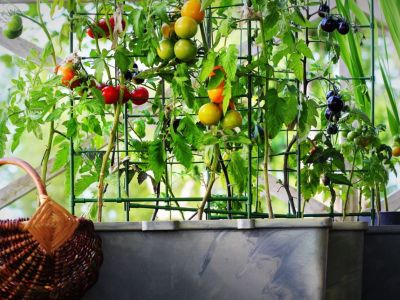Successful Container Gardening in the Central Region
Growing a successful potted vegetable garden begins with the proper selection of containers. Large containers provide more room for root growth than smaller ones. Since they hold more soil, larger planters don’t dry out as quickly and there is less chance of nutrient depletion. Unfortunately, large store-bought flowerpots can be quite pricey. To control the initial cost of a potted vegetable garden, consider using inexpensive five gallon buckets, large storage totes, or recycled potting soil bags. As long as the container doesn’t contain harmful chemicals and drainage holes can be added, almost anything which holds soil can be used for container gardening in the Central region. Once containers are acquired, the next step for growing Ohio Valley container veggies is choosing a growing medium. Soilless mixtures are often preferred for cultivating vegetables in containers. Made from sand, perlite, vermiculite and sphagnum moss, soilless growing mediums are less likely to contain pests and disease organisms. These mixes are lightweight and provide excellent drainage. Finally, plant size and density contributes to the success of container gardening in the Central region. Dwarf varieties of vegetables tend to have a more compact growth pattern making them better adapted for containers than full-sized plants. Additionally, limiting the number of plants per pot prevents overcrowding.
Ohio Valley Container Veggies
Here are veggie-specific suggestions for container gardening in the Central region:
Beets – Space 2 to 3 inches (5-7.6 cm.) apart in an 8-12 inch (20-30 cm.) 2 gallon container.Broccoli – Place 1 plant per 3-5 gallons of soil. Cabbage – Limit one plant per gallon of soil.Carrots – Use a deep container and thin seedlings 2-3 inches (5-7.6 cm.) apart.Cucumbers – Thin to 2 plants per 3 gallons of soil. Provide a trellis or use a hanging planter.Eggplant – Limit 1 plant per 2 gallon container. Green Beans – Sow 3 to 4 seeds in a gallon container.Herbs – Use a one gallon container for small leafy herbs such as basil, parsley, and cilantro.Leaf lettuce – Thin 4-6 plants per gallon of soil. Can be grown in shallow containers.Onion – Plant onion sets 3-4 inches (7.6-10 cm.) apart in an 8-12 inch (20-30 cm.) deep container. Pepper – Transplant 1 pepper per 2-3 gallon container. Radish – Use an 8-10 inch (20-25 cm.) deep container and thin seedlings 2-3 inches (5-7.6 cm.) apart.Spinach – Plant 1-2 inches (5-7.6 cm.) apart in 1-2 gallon planters.Squash and Zucchini – Use a 12-18 inch (30-46 cm.) deep container and limit 2 plants per 3-5 gallons of soil.Swiss Chard – limit 1 plant per gallon of soil.Tomatoes – Choose patio or cherry tomato varieties. Limit one plant per gallon of soil. For standard-sized tomatoes, use a 3-5 gallon container per plant.
